Effective Teaching: Learning, Assessment, and Inclusive Practices
VerifiedAdded on 2023/06/11
|13
|4113
|208
Report
AI Summary
This report provides a comprehensive overview of teaching, learning, and assessment in education and training, emphasizing the importance of meeting individual learner needs and promoting equality and diversity. It discusses various strategies for adapting teaching and learning plans, creating safe and inclusive learning environments, and utilizing inclusive teaching approaches and resources. The report also examines the role of feedback, self-assessment, and peer assessment in the learning process, along with effective communication of assessment information to relevant stakeholders. Furthermore, it analyzes the effectiveness of teaching and learning approaches, communication methods, and resources in relation to meeting individual needs, and explores the application of minimum core elements in planning, delivering, and assessing inclusive teaching and learning. The report concludes with a review of the effectiveness of current practices and identifies areas for improvement, highlighting the importance of continuous reflection and adaptation in the pursuit of inclusive and effective education.
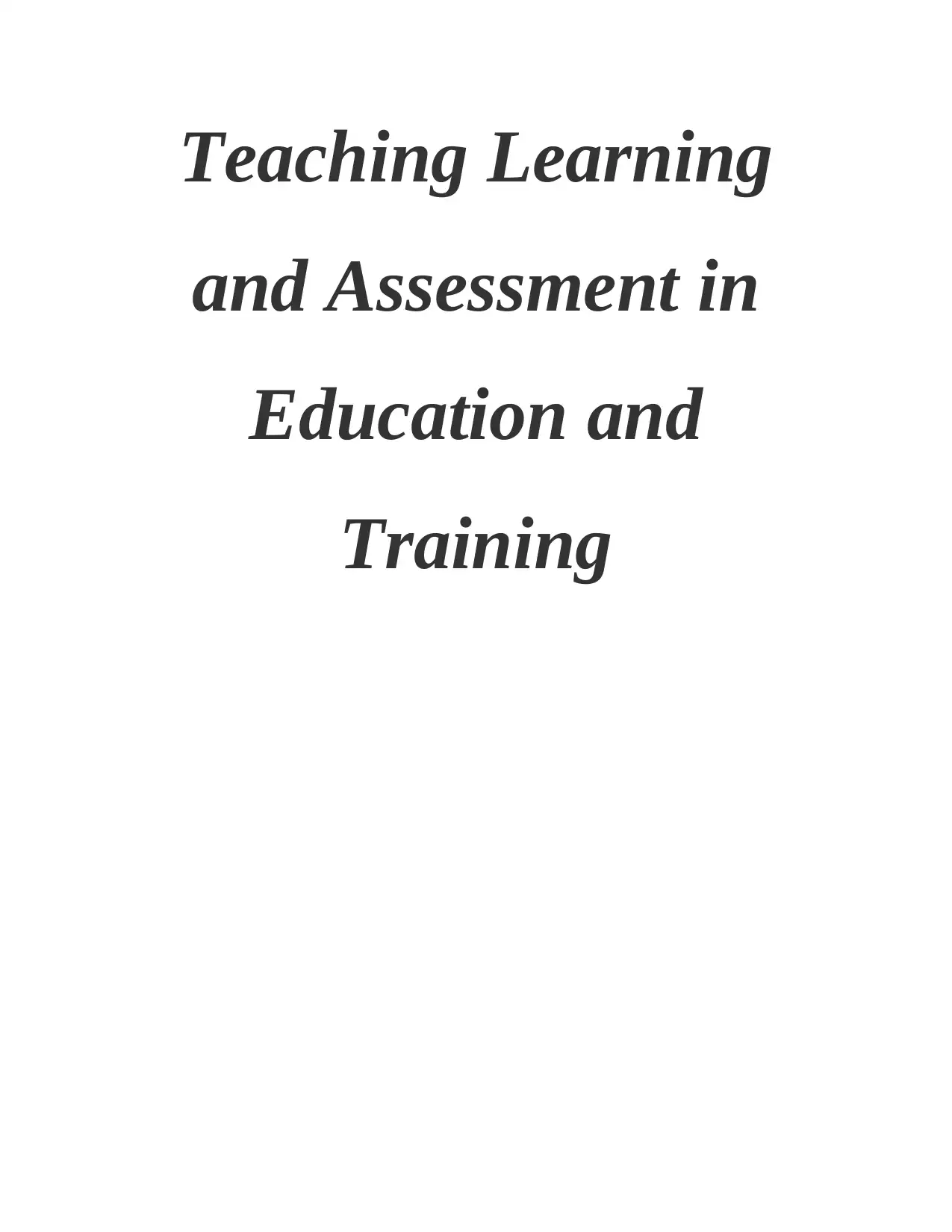
Teaching Learning
and Assessment in
Education and
Training
and Assessment in
Education and
Training
Paraphrase This Document
Need a fresh take? Get an instant paraphrase of this document with our AI Paraphraser
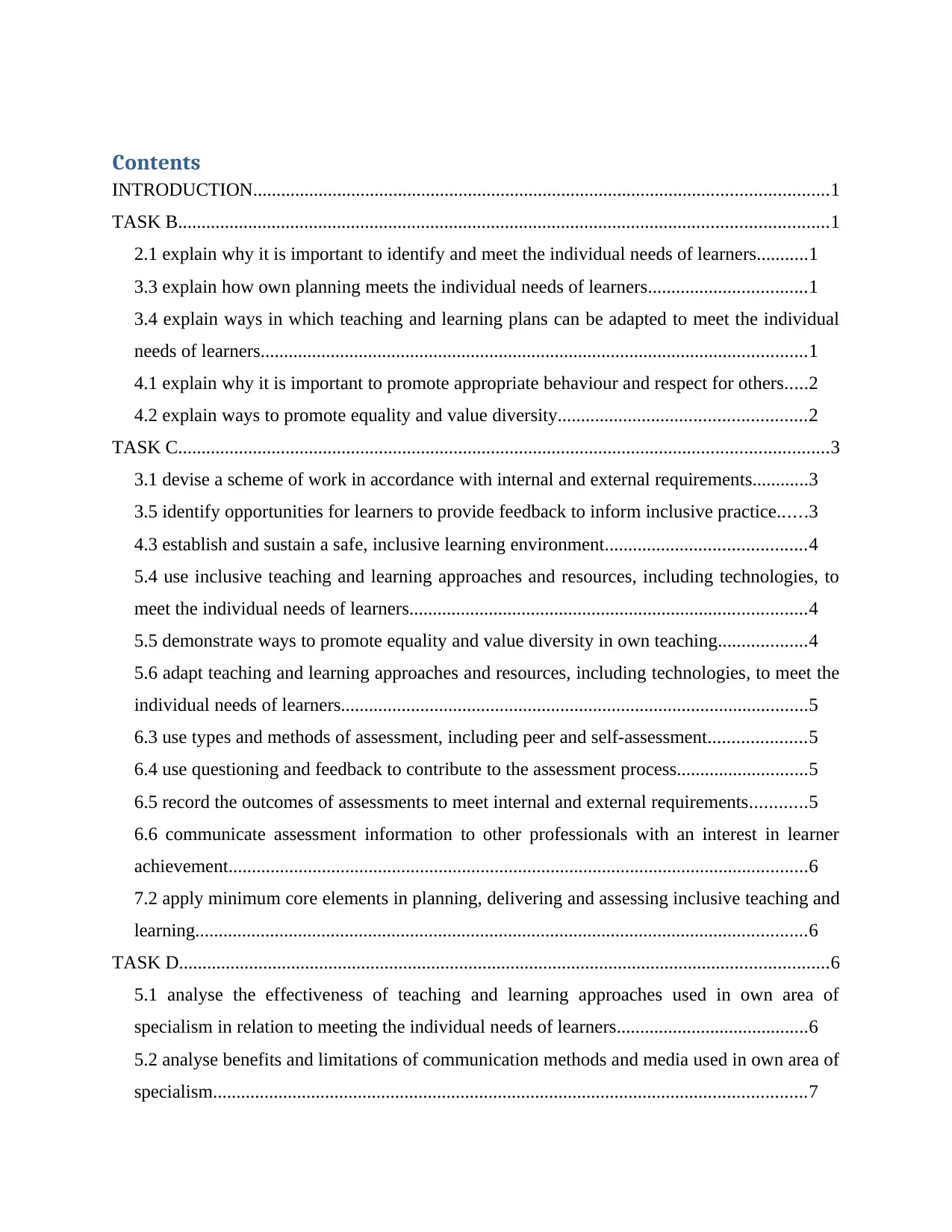
Contents
INTRODUCTION...........................................................................................................................1
TASK B...........................................................................................................................................1
2.1 explain why it is important to identify and meet the individual needs of learners...........1
3.3 explain how own planning meets the individual needs of learners..................................1
3.4 explain ways in which teaching and learning plans can be adapted to meet the individual
needs of learners.....................................................................................................................1
4.1 explain why it is important to promote appropriate behaviour and respect for others.....2
4.2 explain ways to promote equality and value diversity.....................................................2
TASK C...........................................................................................................................................3
3.1 devise a scheme of work in accordance with internal and external requirements............3
3.5 identify opportunities for learners to provide feedback to inform inclusive practice......3
4.3 establish and sustain a safe, inclusive learning environment...........................................4
5.4 use inclusive teaching and learning approaches and resources, including technologies, to
meet the individual needs of learners.....................................................................................4
5.5 demonstrate ways to promote equality and value diversity in own teaching...................4
5.6 adapt teaching and learning approaches and resources, including technologies, to meet the
individual needs of learners....................................................................................................5
6.3 use types and methods of assessment, including peer and self-assessment.....................5
6.4 use questioning and feedback to contribute to the assessment process............................5
6.5 record the outcomes of assessments to meet internal and external requirements............5
6.6 communicate assessment information to other professionals with an interest in learner
achievement............................................................................................................................6
7.2 apply minimum core elements in planning, delivering and assessing inclusive teaching and
learning...................................................................................................................................6
TASK D...........................................................................................................................................6
5.1 analyse the effectiveness of teaching and learning approaches used in own area of
specialism in relation to meeting the individual needs of learners.........................................6
5.2 analyse benefits and limitations of communication methods and media used in own area of
specialism...............................................................................................................................7
INTRODUCTION...........................................................................................................................1
TASK B...........................................................................................................................................1
2.1 explain why it is important to identify and meet the individual needs of learners...........1
3.3 explain how own planning meets the individual needs of learners..................................1
3.4 explain ways in which teaching and learning plans can be adapted to meet the individual
needs of learners.....................................................................................................................1
4.1 explain why it is important to promote appropriate behaviour and respect for others.....2
4.2 explain ways to promote equality and value diversity.....................................................2
TASK C...........................................................................................................................................3
3.1 devise a scheme of work in accordance with internal and external requirements............3
3.5 identify opportunities for learners to provide feedback to inform inclusive practice......3
4.3 establish and sustain a safe, inclusive learning environment...........................................4
5.4 use inclusive teaching and learning approaches and resources, including technologies, to
meet the individual needs of learners.....................................................................................4
5.5 demonstrate ways to promote equality and value diversity in own teaching...................4
5.6 adapt teaching and learning approaches and resources, including technologies, to meet the
individual needs of learners....................................................................................................5
6.3 use types and methods of assessment, including peer and self-assessment.....................5
6.4 use questioning and feedback to contribute to the assessment process............................5
6.5 record the outcomes of assessments to meet internal and external requirements............5
6.6 communicate assessment information to other professionals with an interest in learner
achievement............................................................................................................................6
7.2 apply minimum core elements in planning, delivering and assessing inclusive teaching and
learning...................................................................................................................................6
TASK D...........................................................................................................................................6
5.1 analyse the effectiveness of teaching and learning approaches used in own area of
specialism in relation to meeting the individual needs of learners.........................................6
5.2 analyse benefits and limitations of communication methods and media used in own area of
specialism...............................................................................................................................7
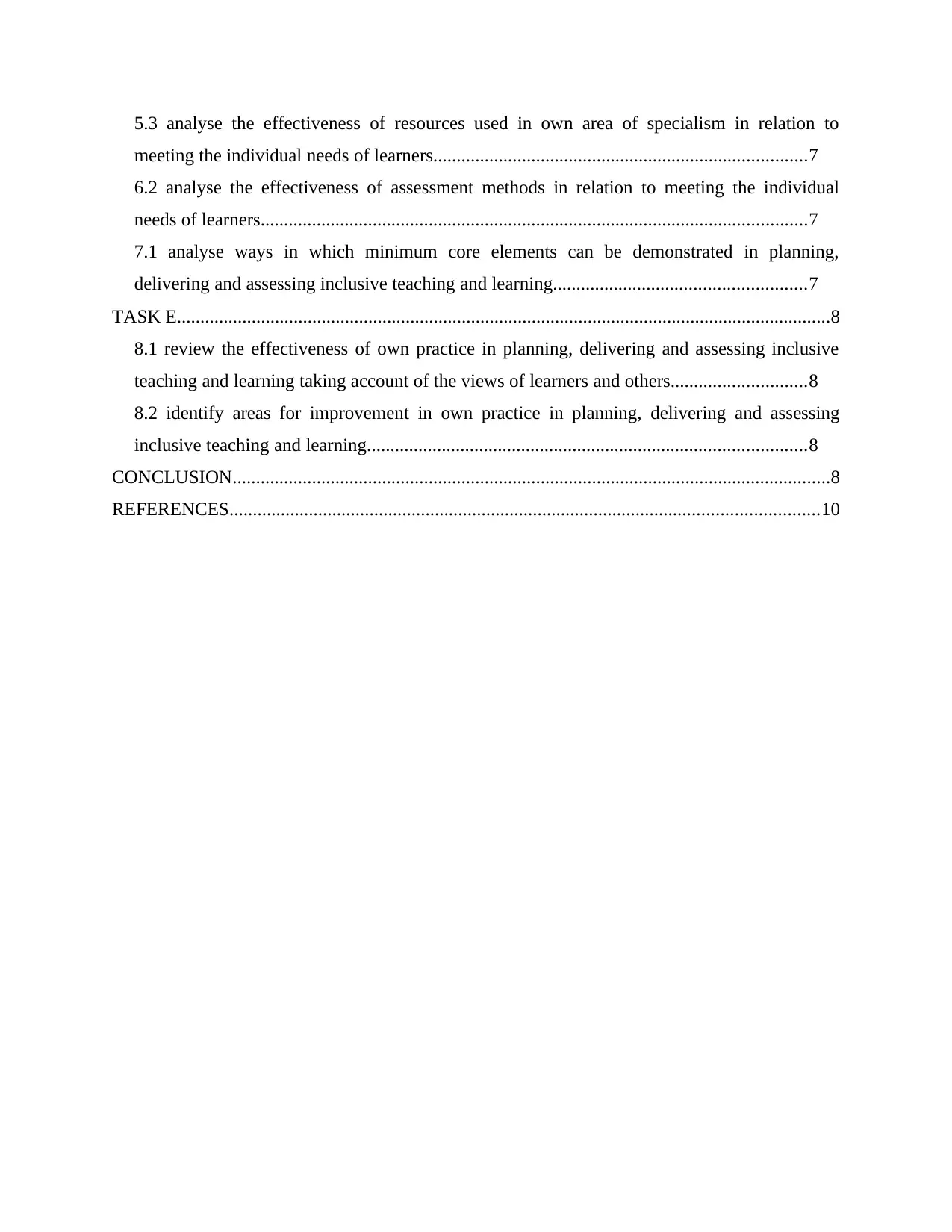
5.3 analyse the effectiveness of resources used in own area of specialism in relation to
meeting the individual needs of learners................................................................................7
6.2 analyse the effectiveness of assessment methods in relation to meeting the individual
needs of learners.....................................................................................................................7
7.1 analyse ways in which minimum core elements can be demonstrated in planning,
delivering and assessing inclusive teaching and learning......................................................7
TASK E............................................................................................................................................8
8.1 review the effectiveness of own practice in planning, delivering and assessing inclusive
teaching and learning taking account of the views of learners and others.............................8
8.2 identify areas for improvement in own practice in planning, delivering and assessing
inclusive teaching and learning..............................................................................................8
CONCLUSION................................................................................................................................8
REFERENCES..............................................................................................................................10
meeting the individual needs of learners................................................................................7
6.2 analyse the effectiveness of assessment methods in relation to meeting the individual
needs of learners.....................................................................................................................7
7.1 analyse ways in which minimum core elements can be demonstrated in planning,
delivering and assessing inclusive teaching and learning......................................................7
TASK E............................................................................................................................................8
8.1 review the effectiveness of own practice in planning, delivering and assessing inclusive
teaching and learning taking account of the views of learners and others.............................8
8.2 identify areas for improvement in own practice in planning, delivering and assessing
inclusive teaching and learning..............................................................................................8
CONCLUSION................................................................................................................................8
REFERENCES..............................................................................................................................10
⊘ This is a preview!⊘
Do you want full access?
Subscribe today to unlock all pages.

Trusted by 1+ million students worldwide
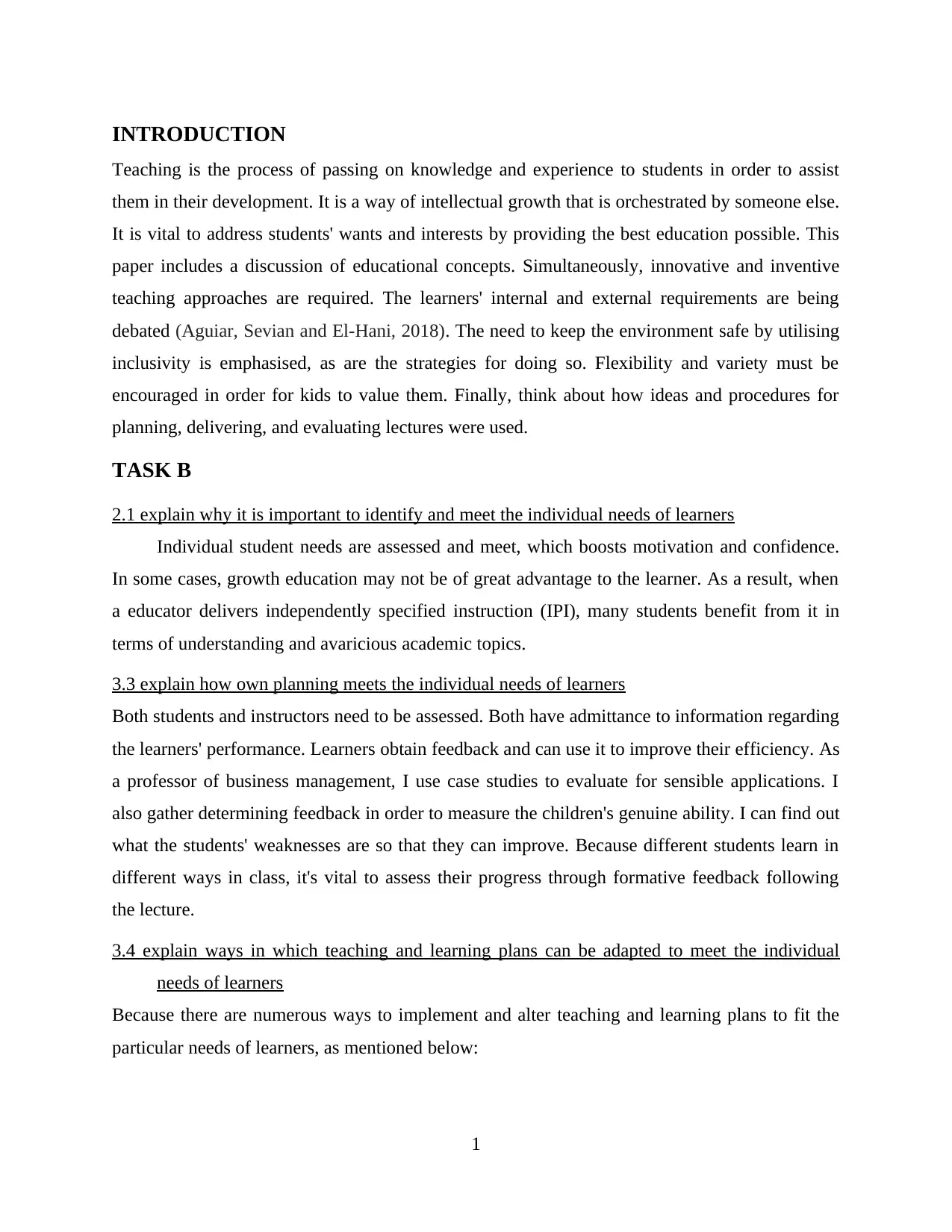
INTRODUCTION
Teaching is the process of passing on knowledge and experience to students in order to assist
them in their development. It is a way of intellectual growth that is orchestrated by someone else.
It is vital to address students' wants and interests by providing the best education possible. This
paper includes a discussion of educational concepts. Simultaneously, innovative and inventive
teaching approaches are required. The learners' internal and external requirements are being
debated (Aguiar, Sevian and El-Hani, 2018). The need to keep the environment safe by utilising
inclusivity is emphasised, as are the strategies for doing so. Flexibility and variety must be
encouraged in order for kids to value them. Finally, think about how ideas and procedures for
planning, delivering, and evaluating lectures were used.
TASK B
2.1 explain why it is important to identify and meet the individual needs of learners
Individual student needs are assessed and meet, which boosts motivation and confidence.
In some cases, growth education may not be of great advantage to the learner. As a result, when
a educator delivers independently specified instruction (IPI), many students benefit from it in
terms of understanding and avaricious academic topics.
3.3 explain how own planning meets the individual needs of learners
Both students and instructors need to be assessed. Both have admittance to information regarding
the learners' performance. Learners obtain feedback and can use it to improve their efficiency. As
a professor of business management, I use case studies to evaluate for sensible applications. I
also gather determining feedback in order to measure the children's genuine ability. I can find out
what the students' weaknesses are so that they can improve. Because different students learn in
different ways in class, it's vital to assess their progress through formative feedback following
the lecture.
3.4 explain ways in which teaching and learning plans can be adapted to meet the individual
needs of learners
Because there are numerous ways to implement and alter teaching and learning plans to fit the
particular needs of learners, as mentioned below:
1
Teaching is the process of passing on knowledge and experience to students in order to assist
them in their development. It is a way of intellectual growth that is orchestrated by someone else.
It is vital to address students' wants and interests by providing the best education possible. This
paper includes a discussion of educational concepts. Simultaneously, innovative and inventive
teaching approaches are required. The learners' internal and external requirements are being
debated (Aguiar, Sevian and El-Hani, 2018). The need to keep the environment safe by utilising
inclusivity is emphasised, as are the strategies for doing so. Flexibility and variety must be
encouraged in order for kids to value them. Finally, think about how ideas and procedures for
planning, delivering, and evaluating lectures were used.
TASK B
2.1 explain why it is important to identify and meet the individual needs of learners
Individual student needs are assessed and meet, which boosts motivation and confidence.
In some cases, growth education may not be of great advantage to the learner. As a result, when
a educator delivers independently specified instruction (IPI), many students benefit from it in
terms of understanding and avaricious academic topics.
3.3 explain how own planning meets the individual needs of learners
Both students and instructors need to be assessed. Both have admittance to information regarding
the learners' performance. Learners obtain feedback and can use it to improve their efficiency. As
a professor of business management, I use case studies to evaluate for sensible applications. I
also gather determining feedback in order to measure the children's genuine ability. I can find out
what the students' weaknesses are so that they can improve. Because different students learn in
different ways in class, it's vital to assess their progress through formative feedback following
the lecture.
3.4 explain ways in which teaching and learning plans can be adapted to meet the individual
needs of learners
Because there are numerous ways to implement and alter teaching and learning plans to fit the
particular needs of learners, as mentioned below:
1
Paraphrase This Document
Need a fresh take? Get an instant paraphrase of this document with our AI Paraphraser
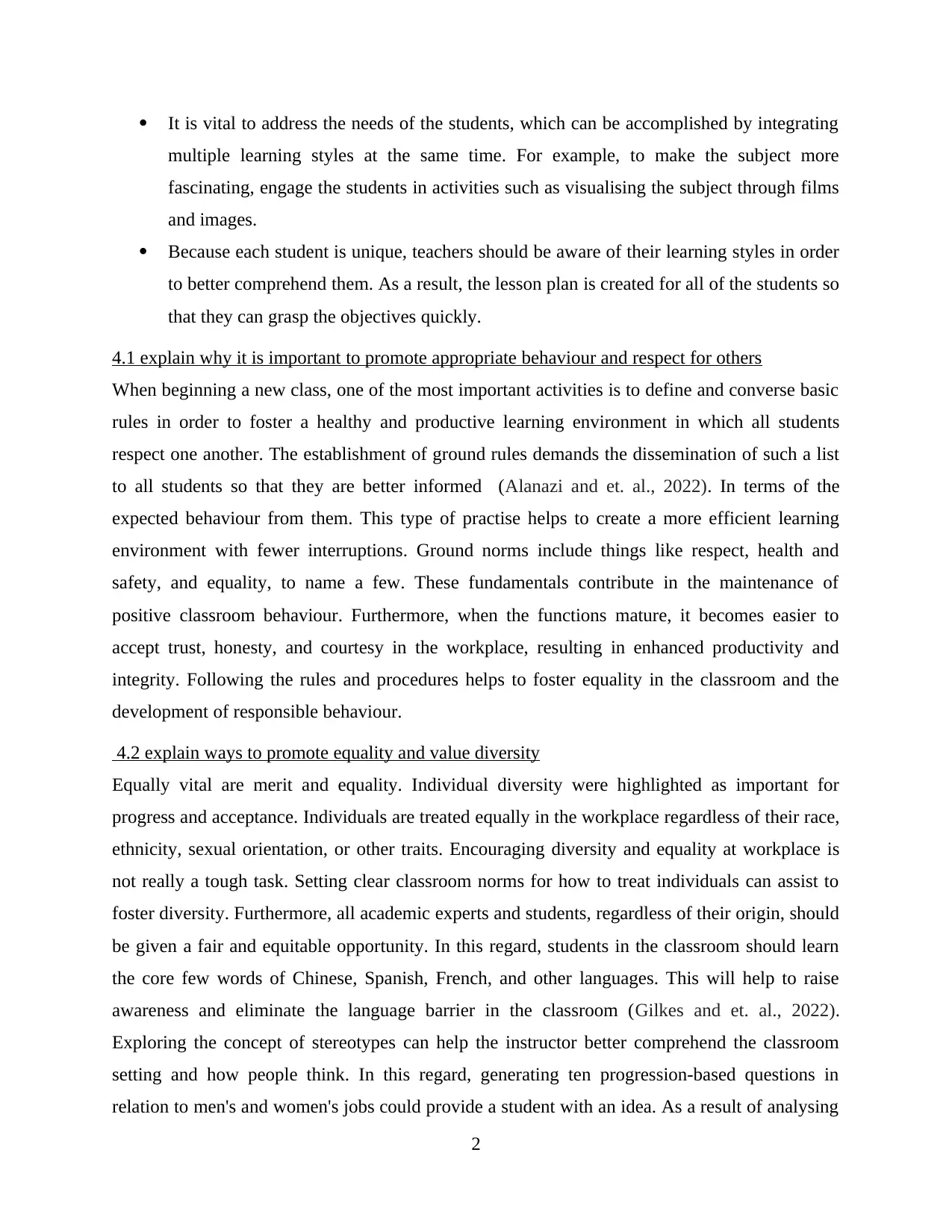
It is vital to address the needs of the students, which can be accomplished by integrating
multiple learning styles at the same time. For example, to make the subject more
fascinating, engage the students in activities such as visualising the subject through films
and images.
Because each student is unique, teachers should be aware of their learning styles in order
to better comprehend them. As a result, the lesson plan is created for all of the students so
that they can grasp the objectives quickly.
4.1 explain why it is important to promote appropriate behaviour and respect for others
When beginning a new class, one of the most important activities is to define and converse basic
rules in order to foster a healthy and productive learning environment in which all students
respect one another. The establishment of ground rules demands the dissemination of such a list
to all students so that they are better informed (Alanazi and et. al., 2022). In terms of the
expected behaviour from them. This type of practise helps to create a more efficient learning
environment with fewer interruptions. Ground norms include things like respect, health and
safety, and equality, to name a few. These fundamentals contribute in the maintenance of
positive classroom behaviour. Furthermore, when the functions mature, it becomes easier to
accept trust, honesty, and courtesy in the workplace, resulting in enhanced productivity and
integrity. Following the rules and procedures helps to foster equality in the classroom and the
development of responsible behaviour.
4.2 explain ways to promote equality and value diversity
Equally vital are merit and equality. Individual diversity were highlighted as important for
progress and acceptance. Individuals are treated equally in the workplace regardless of their race,
ethnicity, sexual orientation, or other traits. Encouraging diversity and equality at workplace is
not really a tough task. Setting clear classroom norms for how to treat individuals can assist to
foster diversity. Furthermore, all academic experts and students, regardless of their origin, should
be given a fair and equitable opportunity. In this regard, students in the classroom should learn
the core few words of Chinese, Spanish, French, and other languages. This will help to raise
awareness and eliminate the language barrier in the classroom (Gilkes and et. al., 2022).
Exploring the concept of stereotypes can help the instructor better comprehend the classroom
setting and how people think. In this regard, generating ten progression-based questions in
relation to men's and women's jobs could provide a student with an idea. As a result of analysing
2
multiple learning styles at the same time. For example, to make the subject more
fascinating, engage the students in activities such as visualising the subject through films
and images.
Because each student is unique, teachers should be aware of their learning styles in order
to better comprehend them. As a result, the lesson plan is created for all of the students so
that they can grasp the objectives quickly.
4.1 explain why it is important to promote appropriate behaviour and respect for others
When beginning a new class, one of the most important activities is to define and converse basic
rules in order to foster a healthy and productive learning environment in which all students
respect one another. The establishment of ground rules demands the dissemination of such a list
to all students so that they are better informed (Alanazi and et. al., 2022). In terms of the
expected behaviour from them. This type of practise helps to create a more efficient learning
environment with fewer interruptions. Ground norms include things like respect, health and
safety, and equality, to name a few. These fundamentals contribute in the maintenance of
positive classroom behaviour. Furthermore, when the functions mature, it becomes easier to
accept trust, honesty, and courtesy in the workplace, resulting in enhanced productivity and
integrity. Following the rules and procedures helps to foster equality in the classroom and the
development of responsible behaviour.
4.2 explain ways to promote equality and value diversity
Equally vital are merit and equality. Individual diversity were highlighted as important for
progress and acceptance. Individuals are treated equally in the workplace regardless of their race,
ethnicity, sexual orientation, or other traits. Encouraging diversity and equality at workplace is
not really a tough task. Setting clear classroom norms for how to treat individuals can assist to
foster diversity. Furthermore, all academic experts and students, regardless of their origin, should
be given a fair and equitable opportunity. In this regard, students in the classroom should learn
the core few words of Chinese, Spanish, French, and other languages. This will help to raise
awareness and eliminate the language barrier in the classroom (Gilkes and et. al., 2022).
Exploring the concept of stereotypes can help the instructor better comprehend the classroom
setting and how people think. In this regard, generating ten progression-based questions in
relation to men's and women's jobs could provide a student with an idea. As a result of analysing
2
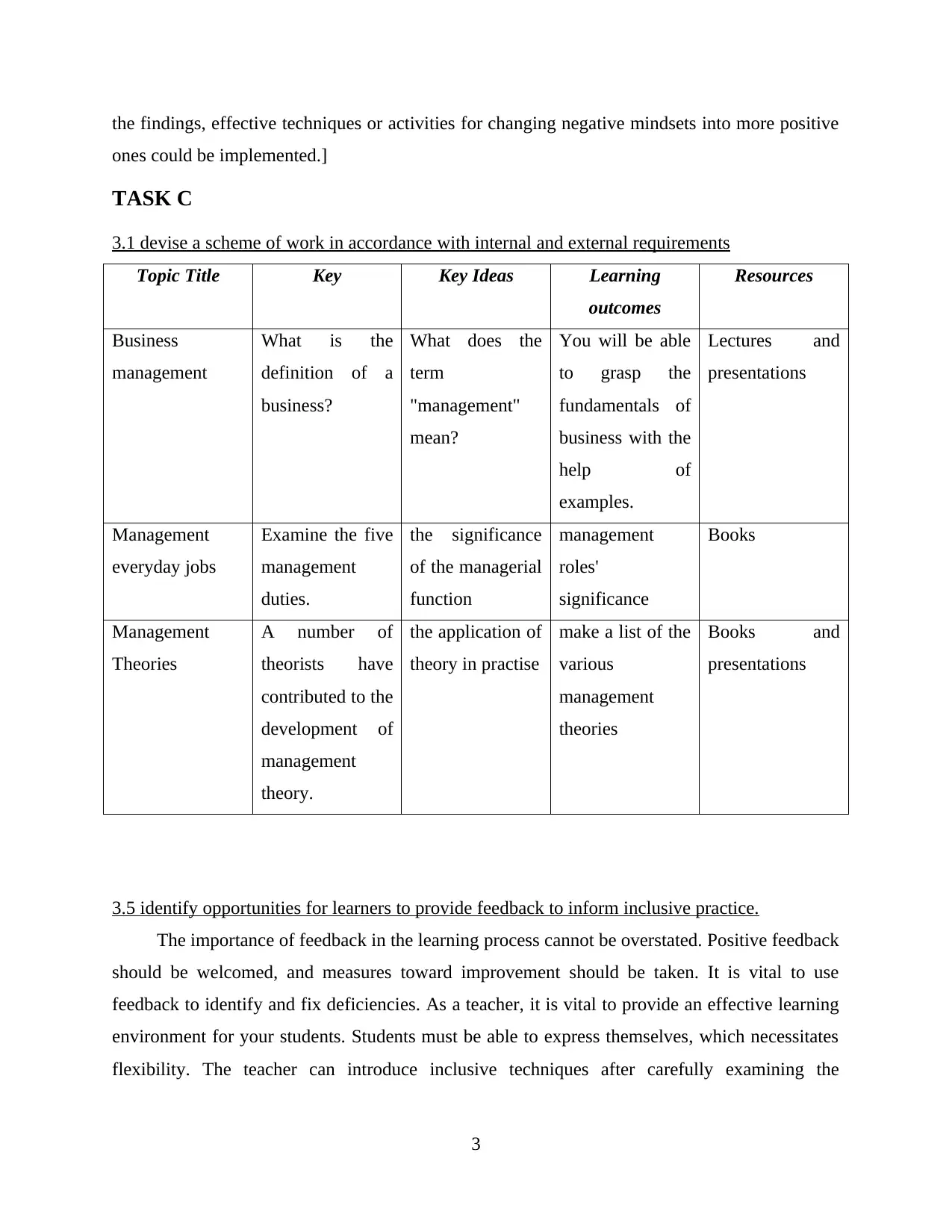
the findings, effective techniques or activities for changing negative mindsets into more positive
ones could be implemented.]
TASK C
3.1 devise a scheme of work in accordance with internal and external requirements
Topic Title Key Key Ideas Learning
outcomes
Resources
Business
management
What is the
definition of a
business?
What does the
term
"management"
mean?
You will be able
to grasp the
fundamentals of
business with the
help of
examples.
Lectures and
presentations
Management
everyday jobs
Examine the five
management
duties.
the significance
of the managerial
function
management
roles'
significance
Books
Management
Theories
A number of
theorists have
contributed to the
development of
management
theory.
the application of
theory in practise
make a list of the
various
management
theories
Books and
presentations
3.5 identify opportunities for learners to provide feedback to inform inclusive practice.
The importance of feedback in the learning process cannot be overstated. Positive feedback
should be welcomed, and measures toward improvement should be taken. It is vital to use
feedback to identify and fix deficiencies. As a teacher, it is vital to provide an effective learning
environment for your students. Students must be able to express themselves, which necessitates
flexibility. The teacher can introduce inclusive techniques after carefully examining the
3
ones could be implemented.]
TASK C
3.1 devise a scheme of work in accordance with internal and external requirements
Topic Title Key Key Ideas Learning
outcomes
Resources
Business
management
What is the
definition of a
business?
What does the
term
"management"
mean?
You will be able
to grasp the
fundamentals of
business with the
help of
examples.
Lectures and
presentations
Management
everyday jobs
Examine the five
management
duties.
the significance
of the managerial
function
management
roles'
significance
Books
Management
Theories
A number of
theorists have
contributed to the
development of
management
theory.
the application of
theory in practise
make a list of the
various
management
theories
Books and
presentations
3.5 identify opportunities for learners to provide feedback to inform inclusive practice.
The importance of feedback in the learning process cannot be overstated. Positive feedback
should be welcomed, and measures toward improvement should be taken. It is vital to use
feedback to identify and fix deficiencies. As a teacher, it is vital to provide an effective learning
environment for your students. Students must be able to express themselves, which necessitates
flexibility. The teacher can introduce inclusive techniques after carefully examining the
3
⊘ This is a preview!⊘
Do you want full access?
Subscribe today to unlock all pages.

Trusted by 1+ million students worldwide
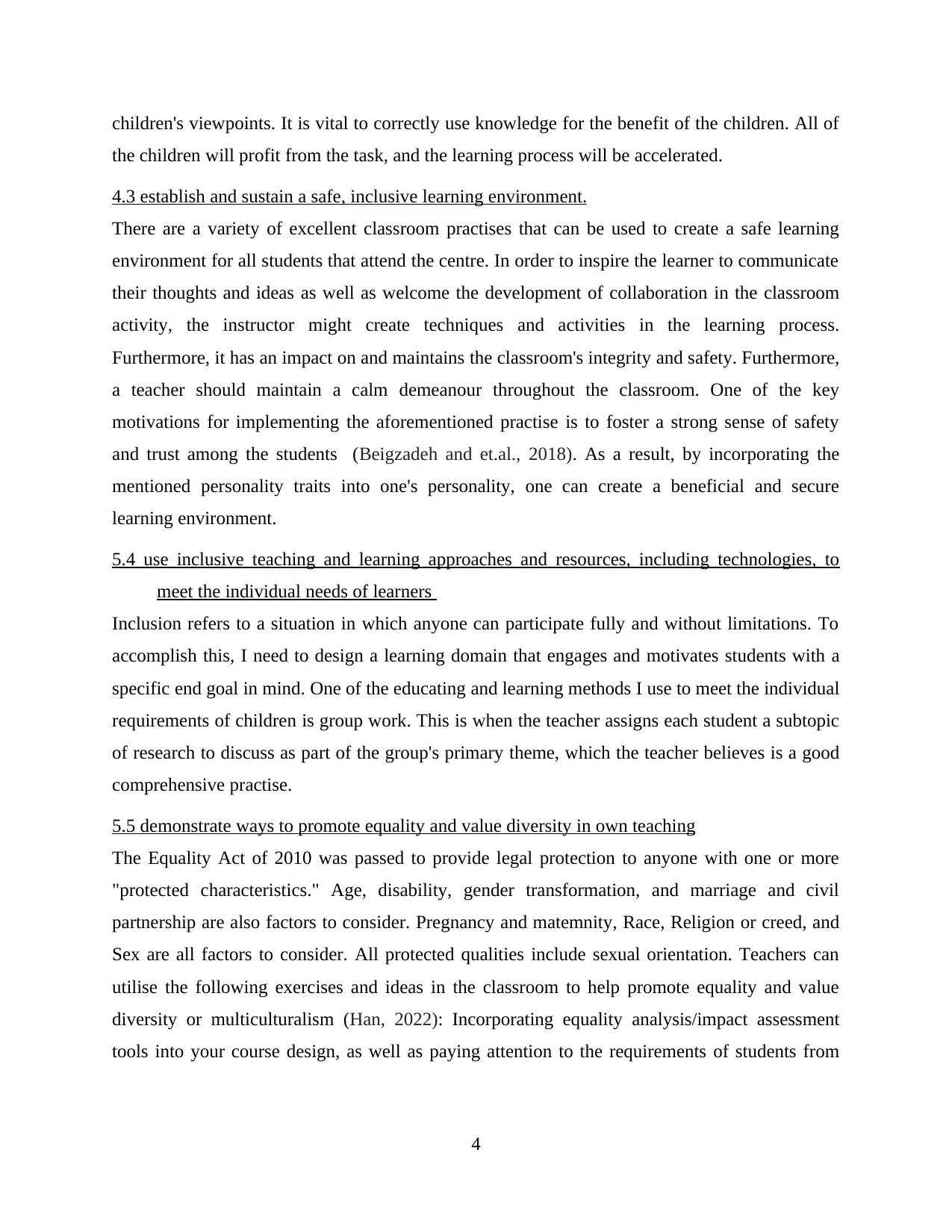
children's viewpoints. It is vital to correctly use knowledge for the benefit of the children. All of
the children will profit from the task, and the learning process will be accelerated.
4.3 establish and sustain a safe, inclusive learning environment.
There are a variety of excellent classroom practises that can be used to create a safe learning
environment for all students that attend the centre. In order to inspire the learner to communicate
their thoughts and ideas as well as welcome the development of collaboration in the classroom
activity, the instructor might create techniques and activities in the learning process.
Furthermore, it has an impact on and maintains the classroom's integrity and safety. Furthermore,
a teacher should maintain a calm demeanour throughout the classroom. One of the key
motivations for implementing the aforementioned practise is to foster a strong sense of safety
and trust among the students (Beigzadeh and et.al., 2018). As a result, by incorporating the
mentioned personality traits into one's personality, one can create a beneficial and secure
learning environment.
5.4 use inclusive teaching and learning approaches and resources, including technologies, to
meet the individual needs of learners
Inclusion refers to a situation in which anyone can participate fully and without limitations. To
accomplish this, I need to design a learning domain that engages and motivates students with a
specific end goal in mind. One of the educating and learning methods I use to meet the individual
requirements of children is group work. This is when the teacher assigns each student a subtopic
of research to discuss as part of the group's primary theme, which the teacher believes is a good
comprehensive practise.
5.5 demonstrate ways to promote equality and value diversity in own teaching
The Equality Act of 2010 was passed to provide legal protection to anyone with one or more
"protected characteristics." Age, disability, gender transformation, and marriage and civil
partnership are also factors to consider. Pregnancy and matemnity, Race, Religion or creed, and
Sex are all factors to consider. All protected qualities include sexual orientation. Teachers can
utilise the following exercises and ideas in the classroom to help promote equality and value
diversity or multiculturalism (Han, 2022): Incorporating equality analysis/impact assessment
tools into your course design, as well as paying attention to the requirements of students from
4
the children will profit from the task, and the learning process will be accelerated.
4.3 establish and sustain a safe, inclusive learning environment.
There are a variety of excellent classroom practises that can be used to create a safe learning
environment for all students that attend the centre. In order to inspire the learner to communicate
their thoughts and ideas as well as welcome the development of collaboration in the classroom
activity, the instructor might create techniques and activities in the learning process.
Furthermore, it has an impact on and maintains the classroom's integrity and safety. Furthermore,
a teacher should maintain a calm demeanour throughout the classroom. One of the key
motivations for implementing the aforementioned practise is to foster a strong sense of safety
and trust among the students (Beigzadeh and et.al., 2018). As a result, by incorporating the
mentioned personality traits into one's personality, one can create a beneficial and secure
learning environment.
5.4 use inclusive teaching and learning approaches and resources, including technologies, to
meet the individual needs of learners
Inclusion refers to a situation in which anyone can participate fully and without limitations. To
accomplish this, I need to design a learning domain that engages and motivates students with a
specific end goal in mind. One of the educating and learning methods I use to meet the individual
requirements of children is group work. This is when the teacher assigns each student a subtopic
of research to discuss as part of the group's primary theme, which the teacher believes is a good
comprehensive practise.
5.5 demonstrate ways to promote equality and value diversity in own teaching
The Equality Act of 2010 was passed to provide legal protection to anyone with one or more
"protected characteristics." Age, disability, gender transformation, and marriage and civil
partnership are also factors to consider. Pregnancy and matemnity, Race, Religion or creed, and
Sex are all factors to consider. All protected qualities include sexual orientation. Teachers can
utilise the following exercises and ideas in the classroom to help promote equality and value
diversity or multiculturalism (Han, 2022): Incorporating equality analysis/impact assessment
tools into your course design, as well as paying attention to the requirements of students from
4
Paraphrase This Document
Need a fresh take? Get an instant paraphrase of this document with our AI Paraphraser
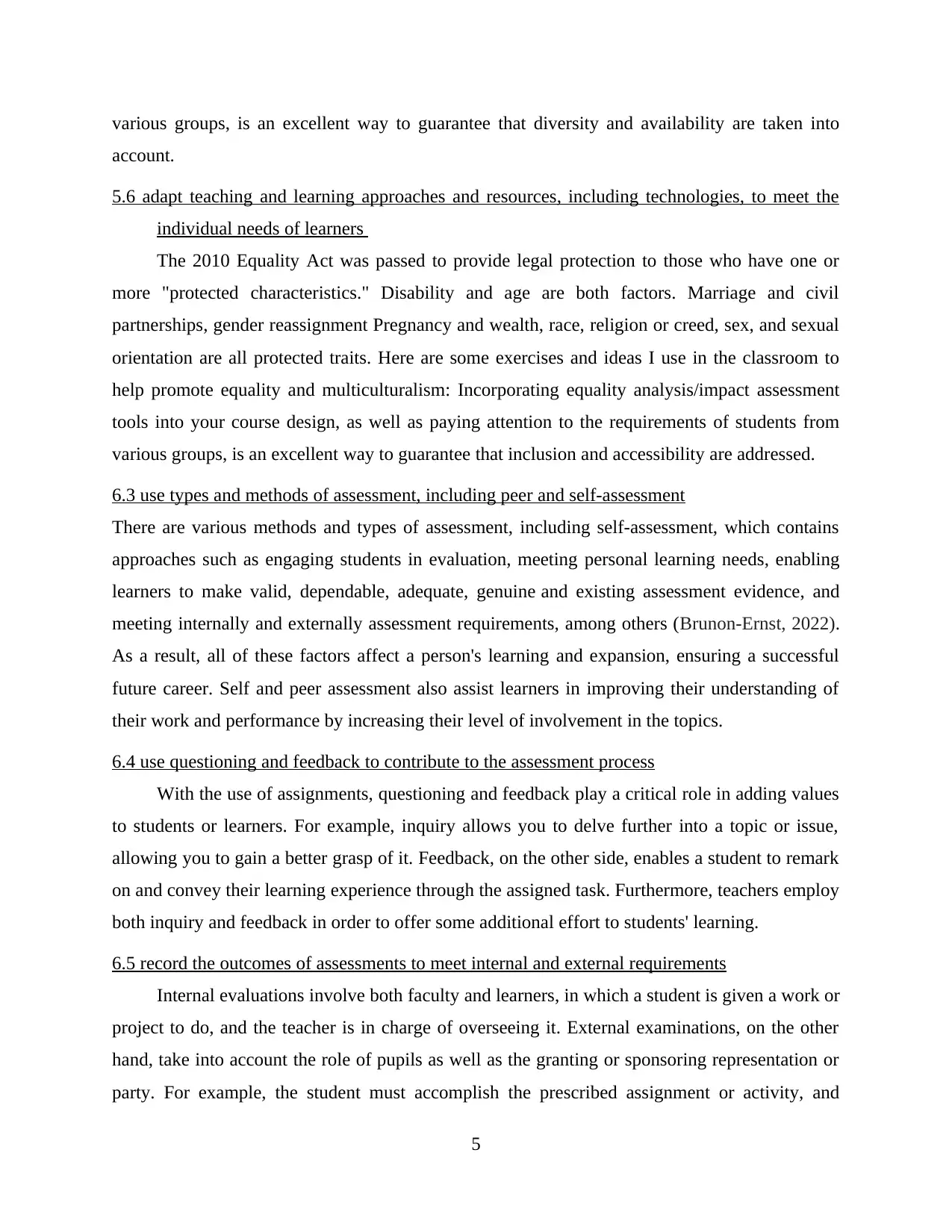
various groups, is an excellent way to guarantee that diversity and availability are taken into
account.
5.6 adapt teaching and learning approaches and resources, including technologies, to meet the
individual needs of learners
The 2010 Equality Act was passed to provide legal protection to those who have one or
more "protected characteristics." Disability and age are both factors. Marriage and civil
partnerships, gender reassignment Pregnancy and wealth, race, religion or creed, sex, and sexual
orientation are all protected traits. Here are some exercises and ideas I use in the classroom to
help promote equality and multiculturalism: Incorporating equality analysis/impact assessment
tools into your course design, as well as paying attention to the requirements of students from
various groups, is an excellent way to guarantee that inclusion and accessibility are addressed.
6.3 use types and methods of assessment, including peer and self-assessment
There are various methods and types of assessment, including self-assessment, which contains
approaches such as engaging students in evaluation, meeting personal learning needs, enabling
learners to make valid, dependable, adequate, genuine and existing assessment evidence, and
meeting internally and externally assessment requirements, among others (Brunon-Ernst, 2022).
As a result, all of these factors affect a person's learning and expansion, ensuring a successful
future career. Self and peer assessment also assist learners in improving their understanding of
their work and performance by increasing their level of involvement in the topics.
6.4 use questioning and feedback to contribute to the assessment process
With the use of assignments, questioning and feedback play a critical role in adding values
to students or learners. For example, inquiry allows you to delve further into a topic or issue,
allowing you to gain a better grasp of it. Feedback, on the other side, enables a student to remark
on and convey their learning experience through the assigned task. Furthermore, teachers employ
both inquiry and feedback in order to offer some additional effort to students' learning.
6.5 record the outcomes of assessments to meet internal and external requirements
Internal evaluations involve both faculty and learners, in which a student is given a work or
project to do, and the teacher is in charge of overseeing it. External examinations, on the other
hand, take into account the role of pupils as well as the granting or sponsoring representation or
party. For example, the student must accomplish the prescribed assignment or activity, and
5
account.
5.6 adapt teaching and learning approaches and resources, including technologies, to meet the
individual needs of learners
The 2010 Equality Act was passed to provide legal protection to those who have one or
more "protected characteristics." Disability and age are both factors. Marriage and civil
partnerships, gender reassignment Pregnancy and wealth, race, religion or creed, sex, and sexual
orientation are all protected traits. Here are some exercises and ideas I use in the classroom to
help promote equality and multiculturalism: Incorporating equality analysis/impact assessment
tools into your course design, as well as paying attention to the requirements of students from
various groups, is an excellent way to guarantee that inclusion and accessibility are addressed.
6.3 use types and methods of assessment, including peer and self-assessment
There are various methods and types of assessment, including self-assessment, which contains
approaches such as engaging students in evaluation, meeting personal learning needs, enabling
learners to make valid, dependable, adequate, genuine and existing assessment evidence, and
meeting internally and externally assessment requirements, among others (Brunon-Ernst, 2022).
As a result, all of these factors affect a person's learning and expansion, ensuring a successful
future career. Self and peer assessment also assist learners in improving their understanding of
their work and performance by increasing their level of involvement in the topics.
6.4 use questioning and feedback to contribute to the assessment process
With the use of assignments, questioning and feedback play a critical role in adding values
to students or learners. For example, inquiry allows you to delve further into a topic or issue,
allowing you to gain a better grasp of it. Feedback, on the other side, enables a student to remark
on and convey their learning experience through the assigned task. Furthermore, teachers employ
both inquiry and feedback in order to offer some additional effort to students' learning.
6.5 record the outcomes of assessments to meet internal and external requirements
Internal evaluations involve both faculty and learners, in which a student is given a work or
project to do, and the teacher is in charge of overseeing it. External examinations, on the other
hand, take into account the role of pupils as well as the granting or sponsoring representation or
party. For example, the student must accomplish the prescribed assignment or activity, and
5
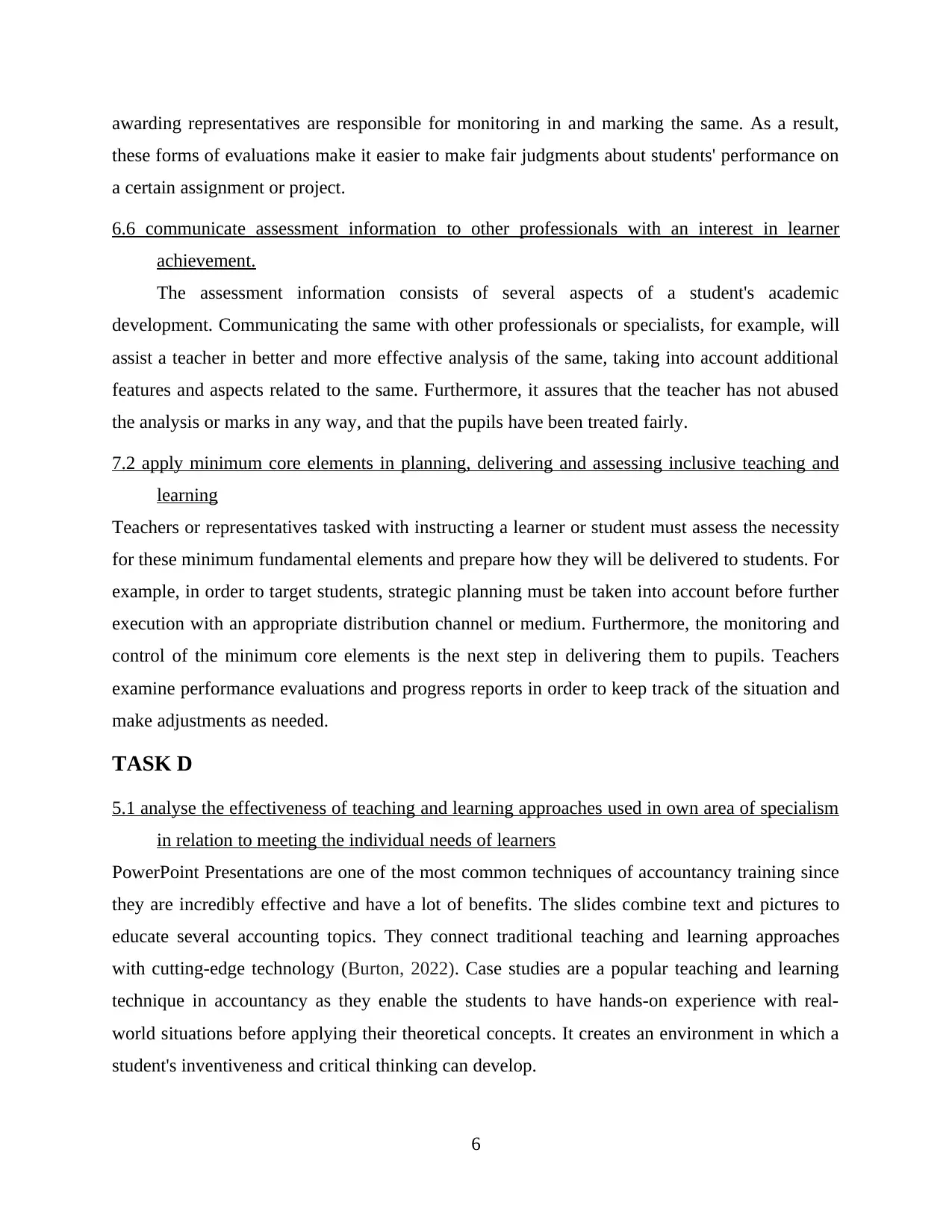
awarding representatives are responsible for monitoring in and marking the same. As a result,
these forms of evaluations make it easier to make fair judgments about students' performance on
a certain assignment or project.
6.6 communicate assessment information to other professionals with an interest in learner
achievement.
The assessment information consists of several aspects of a student's academic
development. Communicating the same with other professionals or specialists, for example, will
assist a teacher in better and more effective analysis of the same, taking into account additional
features and aspects related to the same. Furthermore, it assures that the teacher has not abused
the analysis or marks in any way, and that the pupils have been treated fairly.
7.2 apply minimum core elements in planning, delivering and assessing inclusive teaching and
learning
Teachers or representatives tasked with instructing a learner or student must assess the necessity
for these minimum fundamental elements and prepare how they will be delivered to students. For
example, in order to target students, strategic planning must be taken into account before further
execution with an appropriate distribution channel or medium. Furthermore, the monitoring and
control of the minimum core elements is the next step in delivering them to pupils. Teachers
examine performance evaluations and progress reports in order to keep track of the situation and
make adjustments as needed.
TASK D
5.1 analyse the effectiveness of teaching and learning approaches used in own area of specialism
in relation to meeting the individual needs of learners
PowerPoint Presentations are one of the most common techniques of accountancy training since
they are incredibly effective and have a lot of benefits. The slides combine text and pictures to
educate several accounting topics. They connect traditional teaching and learning approaches
with cutting-edge technology (Burton, 2022). Case studies are a popular teaching and learning
technique in accountancy as they enable the students to have hands-on experience with real-
world situations before applying their theoretical concepts. It creates an environment in which a
student's inventiveness and critical thinking can develop.
6
these forms of evaluations make it easier to make fair judgments about students' performance on
a certain assignment or project.
6.6 communicate assessment information to other professionals with an interest in learner
achievement.
The assessment information consists of several aspects of a student's academic
development. Communicating the same with other professionals or specialists, for example, will
assist a teacher in better and more effective analysis of the same, taking into account additional
features and aspects related to the same. Furthermore, it assures that the teacher has not abused
the analysis or marks in any way, and that the pupils have been treated fairly.
7.2 apply minimum core elements in planning, delivering and assessing inclusive teaching and
learning
Teachers or representatives tasked with instructing a learner or student must assess the necessity
for these minimum fundamental elements and prepare how they will be delivered to students. For
example, in order to target students, strategic planning must be taken into account before further
execution with an appropriate distribution channel or medium. Furthermore, the monitoring and
control of the minimum core elements is the next step in delivering them to pupils. Teachers
examine performance evaluations and progress reports in order to keep track of the situation and
make adjustments as needed.
TASK D
5.1 analyse the effectiveness of teaching and learning approaches used in own area of specialism
in relation to meeting the individual needs of learners
PowerPoint Presentations are one of the most common techniques of accountancy training since
they are incredibly effective and have a lot of benefits. The slides combine text and pictures to
educate several accounting topics. They connect traditional teaching and learning approaches
with cutting-edge technology (Burton, 2022). Case studies are a popular teaching and learning
technique in accountancy as they enable the students to have hands-on experience with real-
world situations before applying their theoretical concepts. It creates an environment in which a
student's inventiveness and critical thinking can develop.
6
⊘ This is a preview!⊘
Do you want full access?
Subscribe today to unlock all pages.

Trusted by 1+ million students worldwide
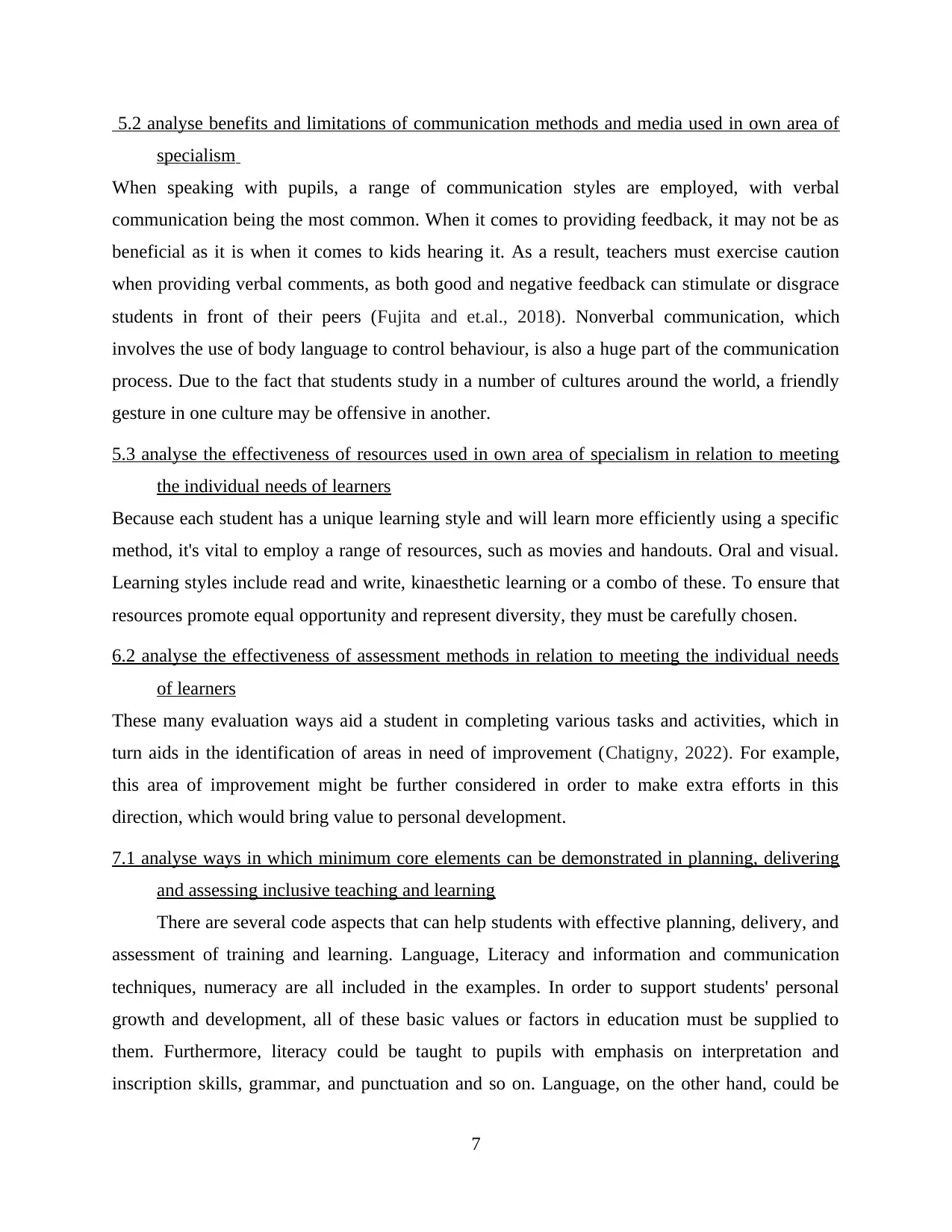
5.2 analyse benefits and limitations of communication methods and media used in own area of
specialism
When speaking with pupils, a range of communication styles are employed, with verbal
communication being the most common. When it comes to providing feedback, it may not be as
beneficial as it is when it comes to kids hearing it. As a result, teachers must exercise caution
when providing verbal comments, as both good and negative feedback can stimulate or disgrace
students in front of their peers (Fujita and et.al., 2018). Nonverbal communication, which
involves the use of body language to control behaviour, is also a huge part of the communication
process. Due to the fact that students study in a number of cultures around the world, a friendly
gesture in one culture may be offensive in another.
5.3 analyse the effectiveness of resources used in own area of specialism in relation to meeting
the individual needs of learners
Because each student has a unique learning style and will learn more efficiently using a specific
method, it's vital to employ a range of resources, such as movies and handouts. Oral and visual.
Learning styles include read and write, kinaesthetic learning or a combo of these. To ensure that
resources promote equal opportunity and represent diversity, they must be carefully chosen.
6.2 analyse the effectiveness of assessment methods in relation to meeting the individual needs
of learners
These many evaluation ways aid a student in completing various tasks and activities, which in
turn aids in the identification of areas in need of improvement (Chatigny, 2022). For example,
this area of improvement might be further considered in order to make extra efforts in this
direction, which would bring value to personal development.
7.1 analyse ways in which minimum core elements can be demonstrated in planning, delivering
and assessing inclusive teaching and learning
There are several code aspects that can help students with effective planning, delivery, and
assessment of training and learning. Language, Literacy and information and communication
techniques, numeracy are all included in the examples. In order to support students' personal
growth and development, all of these basic values or factors in education must be supplied to
them. Furthermore, literacy could be taught to pupils with emphasis on interpretation and
inscription skills, grammar, and punctuation and so on. Language, on the other hand, could be
7
specialism
When speaking with pupils, a range of communication styles are employed, with verbal
communication being the most common. When it comes to providing feedback, it may not be as
beneficial as it is when it comes to kids hearing it. As a result, teachers must exercise caution
when providing verbal comments, as both good and negative feedback can stimulate or disgrace
students in front of their peers (Fujita and et.al., 2018). Nonverbal communication, which
involves the use of body language to control behaviour, is also a huge part of the communication
process. Due to the fact that students study in a number of cultures around the world, a friendly
gesture in one culture may be offensive in another.
5.3 analyse the effectiveness of resources used in own area of specialism in relation to meeting
the individual needs of learners
Because each student has a unique learning style and will learn more efficiently using a specific
method, it's vital to employ a range of resources, such as movies and handouts. Oral and visual.
Learning styles include read and write, kinaesthetic learning or a combo of these. To ensure that
resources promote equal opportunity and represent diversity, they must be carefully chosen.
6.2 analyse the effectiveness of assessment methods in relation to meeting the individual needs
of learners
These many evaluation ways aid a student in completing various tasks and activities, which in
turn aids in the identification of areas in need of improvement (Chatigny, 2022). For example,
this area of improvement might be further considered in order to make extra efforts in this
direction, which would bring value to personal development.
7.1 analyse ways in which minimum core elements can be demonstrated in planning, delivering
and assessing inclusive teaching and learning
There are several code aspects that can help students with effective planning, delivery, and
assessment of training and learning. Language, Literacy and information and communication
techniques, numeracy are all included in the examples. In order to support students' personal
growth and development, all of these basic values or factors in education must be supplied to
them. Furthermore, literacy could be taught to pupils with emphasis on interpretation and
inscription skills, grammar, and punctuation and so on. Language, on the other hand, could be
7
Paraphrase This Document
Need a fresh take? Get an instant paraphrase of this document with our AI Paraphraser
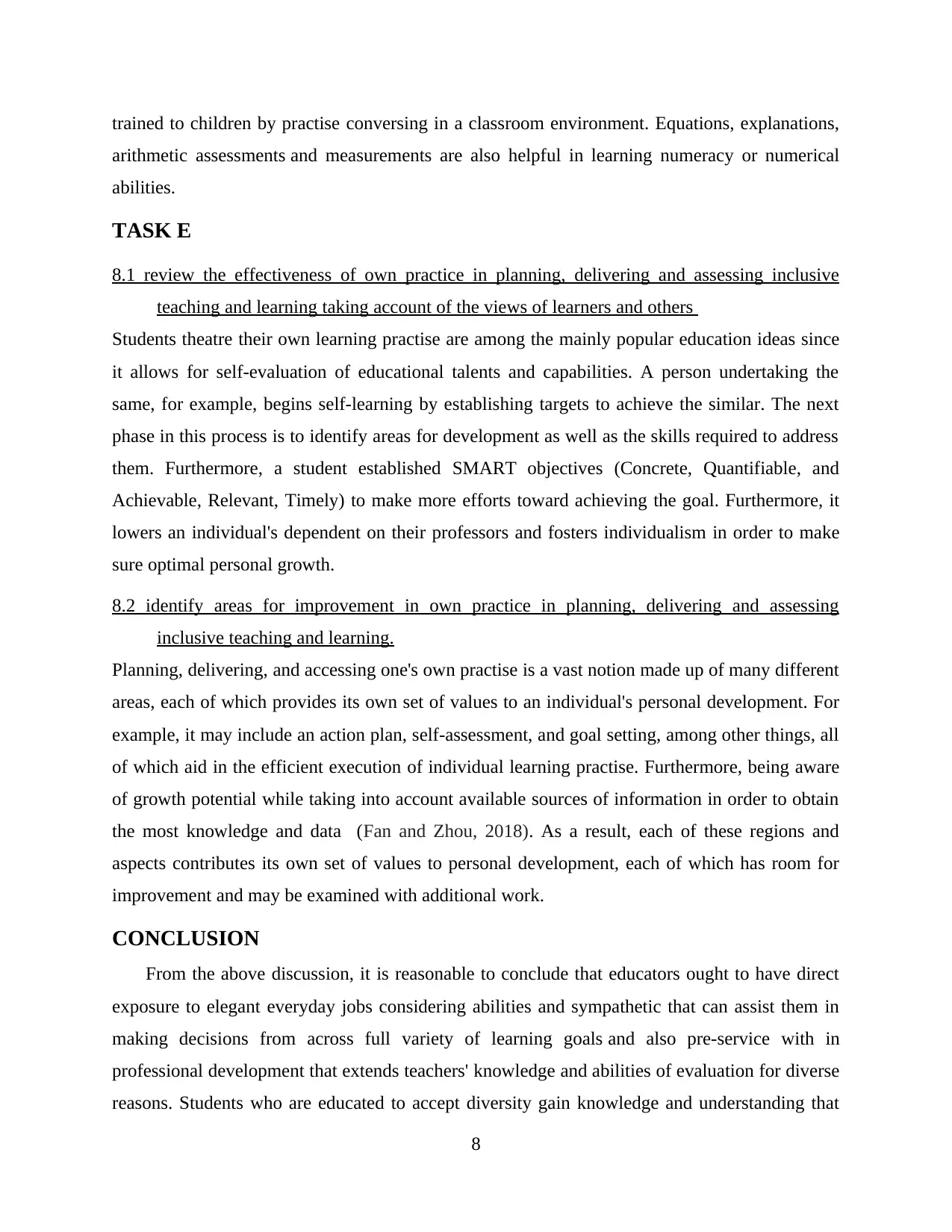
trained to children by practise conversing in a classroom environment. Equations, explanations,
arithmetic assessments and measurements are also helpful in learning numeracy or numerical
abilities.
TASK E
8.1 review the effectiveness of own practice in planning, delivering and assessing inclusive
teaching and learning taking account of the views of learners and others
Students theatre their own learning practise are among the mainly popular education ideas since
it allows for self-evaluation of educational talents and capabilities. A person undertaking the
same, for example, begins self-learning by establishing targets to achieve the similar. The next
phase in this process is to identify areas for development as well as the skills required to address
them. Furthermore, a student established SMART objectives (Concrete, Quantifiable, and
Achievable, Relevant, Timely) to make more efforts toward achieving the goal. Furthermore, it
lowers an individual's dependent on their professors and fosters individualism in order to make
sure optimal personal growth.
8.2 identify areas for improvement in own practice in planning, delivering and assessing
inclusive teaching and learning.
Planning, delivering, and accessing one's own practise is a vast notion made up of many different
areas, each of which provides its own set of values to an individual's personal development. For
example, it may include an action plan, self-assessment, and goal setting, among other things, all
of which aid in the efficient execution of individual learning practise. Furthermore, being aware
of growth potential while taking into account available sources of information in order to obtain
the most knowledge and data (Fan and Zhou, 2018). As a result, each of these regions and
aspects contributes its own set of values to personal development, each of which has room for
improvement and may be examined with additional work.
CONCLUSION
From the above discussion, it is reasonable to conclude that educators ought to have direct
exposure to elegant everyday jobs considering abilities and sympathetic that can assist them in
making decisions from across full variety of learning goals and also pre-service with in
professional development that extends teachers' knowledge and abilities of evaluation for diverse
reasons. Students who are educated to accept diversity gain knowledge and understanding that
8
arithmetic assessments and measurements are also helpful in learning numeracy or numerical
abilities.
TASK E
8.1 review the effectiveness of own practice in planning, delivering and assessing inclusive
teaching and learning taking account of the views of learners and others
Students theatre their own learning practise are among the mainly popular education ideas since
it allows for self-evaluation of educational talents and capabilities. A person undertaking the
same, for example, begins self-learning by establishing targets to achieve the similar. The next
phase in this process is to identify areas for development as well as the skills required to address
them. Furthermore, a student established SMART objectives (Concrete, Quantifiable, and
Achievable, Relevant, Timely) to make more efforts toward achieving the goal. Furthermore, it
lowers an individual's dependent on their professors and fosters individualism in order to make
sure optimal personal growth.
8.2 identify areas for improvement in own practice in planning, delivering and assessing
inclusive teaching and learning.
Planning, delivering, and accessing one's own practise is a vast notion made up of many different
areas, each of which provides its own set of values to an individual's personal development. For
example, it may include an action plan, self-assessment, and goal setting, among other things, all
of which aid in the efficient execution of individual learning practise. Furthermore, being aware
of growth potential while taking into account available sources of information in order to obtain
the most knowledge and data (Fan and Zhou, 2018). As a result, each of these regions and
aspects contributes its own set of values to personal development, each of which has room for
improvement and may be examined with additional work.
CONCLUSION
From the above discussion, it is reasonable to conclude that educators ought to have direct
exposure to elegant everyday jobs considering abilities and sympathetic that can assist them in
making decisions from across full variety of learning goals and also pre-service with in
professional development that extends teachers' knowledge and abilities of evaluation for diverse
reasons. Students who are educated to accept diversity gain knowledge and understanding that
8

will help them improve their relationships, fight prejudice, and make good choices through their
lives.
9
lives.
9
⊘ This is a preview!⊘
Do you want full access?
Subscribe today to unlock all pages.

Trusted by 1+ million students worldwide
1 out of 13
Related Documents
Your All-in-One AI-Powered Toolkit for Academic Success.
+13062052269
info@desklib.com
Available 24*7 on WhatsApp / Email
![[object Object]](/_next/static/media/star-bottom.7253800d.svg)
Unlock your academic potential
Copyright © 2020–2025 A2Z Services. All Rights Reserved. Developed and managed by ZUCOL.

